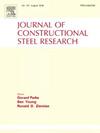New proposal for predicting the patch loading resistance of curved steel I-girders
IF 4
2区 工程技术
Q1 CONSTRUCTION & BUILDING TECHNOLOGY
引用次数: 0
Abstract
Bridges curved in plan are commonly employed in urban areas, particularly in urban interchange structures that require intricated layouts. As a result of this curvature, these structures present significant complexities, both in their performance and design, when compared to equivalent straight girders. This fact explains the limitations of current design specifications, which appear to either inadequately address the design of such girders under different loading scenarios or to offer limited and simplified guidance only. AASHTO adopts a simplified and empirical approach, providing some design guidelines for curved steel plate girders. In contrast, the current and upcoming versions of Eurocode 3 for plated structures (EN 1993-1-5) lack specific provisions for curved steel plate girders, especially regarding their response to patch loading, and the adoption of the provisions for straight girders has been shown to provide rather inaccurate and overly conservative predictions. To address this issue, this paper presents a practical procedure for estimating the patch loading resistance of curved steel I-girders. The work is based on a comprehensive finite element investigation on curved steel plate I-girders subjected to patch loading. The new proposal features a novel expression for calculating the buckling coefficient that considers the effect of curvature for a more accurate prediction of the elastic critical load of curved steel I-girders, in addition to a novel resistance function specific to these structures. The new proposal is found to offer a more precise and consistent resistance prediction, by incorporating curvature effects, that the current provisions for straight girders.
求助全文
约1分钟内获得全文
求助全文
来源期刊

Journal of Constructional Steel Research
工程技术-工程:土木
CiteScore
7.90
自引率
19.50%
发文量
550
审稿时长
46 days
期刊介绍:
The Journal of Constructional Steel Research provides an international forum for the presentation and discussion of the latest developments in structural steel research and their applications. It is aimed not only at researchers but also at those likely to be most affected by research results, i.e. designers and fabricators. Original papers of a high standard dealing with all aspects of steel research including theoretical and experimental research on elements, assemblages, connection and material properties are considered for publication.
 求助内容:
求助内容: 应助结果提醒方式:
应助结果提醒方式:


